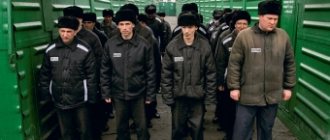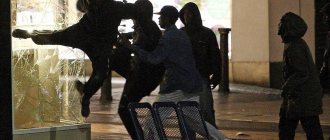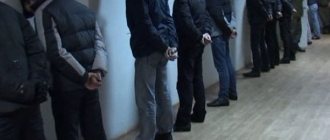In this work we will talk about what an organized crime group and an organized criminal group are. We will talk about crimes committed by organized groups.
In Russia, this form of crime appeared in the sixties of the last century, that is, in the USSR. These groups committed crimes mainly related to selfish goals. They conducted economic activities (shadow or legal). As a rule, these formations had connections with authorities.
Surely, many have heard about the “Russian mafia”. This term was used to describe various criminal organizations. It was originally applied to organized groups in the 70s–90s. This term is still used today.
What are organized crime groups and ops. Criminal groups in Russia
In this work we will talk about what an organized crime group and an organized criminal group are.
We will talk about crimes committed by organized groups. In Russia, this form of crime appeared in the sixties of the last century, that is, in the USSR. These groups committed crimes mainly related to selfish goals. They conducted economic activities (shadow or legal). As a rule, these formations had connections with authorities.
Surely, many have heard about the “Russian mafia”. This term was used to describe various criminal organizations. It was originally applied to organized groups in the 70s–90s. This term is still used today.
What is an organized crime group? This is an organized criminal group. Persons unite to commit one crime or several. It is also important to clarify that this group gathers deliberately and stipulates the details of the crime, that is, an organized crime group is a form of complicity. Both the details of one specific crime and criminal activity in general can be discussed.
Notes
- ↑ Nazarenko G.V. Criminal law. A common part. M., 2005. P. 130.
- ↑ Criminal law of Russia. Practical course / General. ed. A. I. Bastrykina; under scientific ed. A. V. Naumova. M., 2007. P. 137.
- ↑ Criminal law of Russia. Practical course / General. ed. A. I. Bastrykina; under scientific ed. A. V. Naumova. M., 2007. P. 138.
- ↑ Criminal law of Russia. General part / Ed. N. M. Kropacheva, B. V. Volzhenkina, V. V. Orekhova. St. Petersburg, 2006. P. 606.
- ↑ Bykov V. What is an organized criminal group? // Russian justice. 1995. No. 10. P. 41.
- ↑ Criminal law of Russia. Practical course / General. ed. A. I. Bastrykina; under scientific ed. A. V. Naumova. M., 2007. P. 139.
- ↑ Criminal law of Russia. Practical course / General. ed. A. I. Bastrykina; under scientific ed. A. V. Naumova. M., 2007. P. 145.
- ↑ (undefined)
. Gazeta.Ru. Retrieved February 15, 2022. - ↑ (undefined)
. Gazeta.Ru. Retrieved February 15, 2022.
| Criminal law: general part | |
| General provisions | Principles of criminal law · Criminal policy · Criminal law · Criminal legislation · Action of criminal law in space · Action of criminal law in time · Retroactivity of criminal law · Extradition · International criminal law · Criminal liability |
| Crime | Classification of crimes · Qualification of crimes · Composition of a crime |
| Stages of committing a crime | Preparation for a crime · Attempted crime · Voluntary renunciation of a crime |
| Objective signs of crime | Object of the crime · Subject of the crime · Victim · Objective side of the crime · Act in criminal law · Criminal inaction · Socially dangerous consequence · Causality in criminal law · Method of committing the crime · Means and instruments of committing the crime · Place of the crime · Time of the crime · Circumstances of the crime crimes |
| Subjective signs of crime | Subject of the crime · Age of criminal responsibility · Insanity · Limited sanity · Liability of persons who committed crimes while intoxicated · Special subject · Subjective side of the crime · Guilt (criminal law) · Intent · Negligence · Innocent causing of harm · Crimes with two forms of guilt · Motive and purpose of the crime · Affect · Error in criminal law · Criminal legal regime of minors |
| Circumstances excluding the criminality of the act | Necessary defense · Causing harm when apprehending a criminal · Extreme necessity · Justified risk · Physical or mental coercion · Execution of an order or instruction |
| Complicity | Types of accomplices (performer · organizer · instigator · accomplice) · Forms of complicity (group of persons without prior conspiracy · group of persons by prior conspiracy · organized group · criminal community) · Excess of the perpetrator |
| Plurality of crimes | Aggregate of crimes · Competition of criminal law norms · Recidivism of crimes · Repeated crimes · Single crime |
| Punishment | Purposes of punishment · Types of punishment · Assignment of punishment · Conditional sentence · Exemption from criminal liability · Exemption from punishment · Pardon · Amnesty · Criminal record |
| Other measures of criminal law | Compulsory medical measures · Compulsory educational measures · Confiscation of property |
| By country | Criminal law in Canada · |
This page was last edited on May 1, 2022 at 8:45 pm.
Dangerous criminal groups in Russia
What an organized crime group is is explained; below we will list the most dangerous criminal groups that operated in the 90s. In the so-called dashing nineties, the following gangs operated on the territory of our country:
- Volgovskaya organized crime group (“Ruzlyaevskaya”) - the activity consisted of the resale of stolen spare parts for VAZ cars. The last member of this organized crime group was detained in 2016 in St. Petersburg.
- The Slonovskaya (“elephants”) organized crime group was engaged in “protection protection”, fraud with car sales, and the seizure of entire enterprises, thereby amassing huge fortunes. The leader of the gang has not been found to this day; according to some reports, he lives in Europe.
- The Shchelkovo organized crime group carried out criminal activities until the 2000s. The gang became famous for its many murders (they accounted for more than 60 deaths). Members of the group preferred to eliminate their competitors rather than negotiate.
- The Malyshevskaya organized crime group began developing in Russia, but soon moved to Spain; many have heard about the high-profile case called “Russian mafia in Spain.” This is the “merit” of the Malyshevo organized crime group.
This list can be listed endlessly, but we suggest discussing the punishment for a group criminal act.
Autonomous rule of elephants in Ryazan
After the death of Airapetov, the “elephants” no longer had any serious enemies, and then, in fact, they remained the only functioning group in Ryazan[1]. Bandits came to entrepreneurs' homes, offices and boards, and set payment amounts. Those who refused or did not have time to pay faced retribution. Often even an attempt to bargain cost one's life. Thus, the 17-year-old son of the director of a tea distribution factory was shot dead in the entrance[1].
The bandits even took tribute from unprofitable enterprises, collective farms, garage cooperatives, and housing departments[1]. The victims of the racketeering themselves brought the money to Ryazan. The number of “elephant” clients became so large that they began to gather on certain days at the central city stadium of Ryazan[1].
The Slonovskys decided to impose tribute on the gypsies who were drug dealers. When one of them refused, the bandits hacked him to death with an ax and then mutilated his pregnant wife[1].
In December 1993, massive fraud with postal credit memos occurred in Russia. “Elephants” also adopted this type of criminal income. Thus, they stole 900 million rubles using false advice notes. Then they made an unsuccessful attempt to steal 19 billion. If it had been carried out, it would have become the largest theft of money from the Central Bank of Russia[1].
“Elephants” worked in the Yesenin open spaces - places of tourist pilgrimage in the Ryazan region[1]. As mentioned above, “elephants” also used financial pyramids.
At the same time, Ermolov began to be concerned about the behavior of the members of his group, Filaretov, Glazunov and Zhukov, who were adherents of thieves’ ideas. For the “elephants” they posed a serious danger, since the so-called “thieves in law” could seriously compete with them in Ryazan. On March 18, 1996, killers Shpak, Sadovov and Gorelov took Filaretov out of the city, killed him with a knife, threw him into a barrel and set him on fire. The body was soon discovered by a police patrol, but it was identified only a year later. On March 19, Zhukov disappeared without a trace. On March 21, killers Akhmetov and Sergeev killed Glazunov, framing the murder as a domestic crime. Glazunov's wife was seriously wounded, but survived[1].
The “elephants” also did charity work. By providing assistance to orphanages, they were actually training future killers. Thus, a pupil of the orphanage Frolovsky later became a member of the Slonovskaya organized crime group and died when he was blown up by a bomb [1].
Public opinion regarding the “Elephant”, as described in the documentary “Hunting for Elephants” from the “Criminal Russia” series, filmed in 2001, was as follows:
...And the “elephants” already had power over the minds and souls of the townspeople. Against the backdrop of growing unemployment and impoverishment, sharply packaged bandits seemed to be the standard of prosperity. On the one hand, they continued to create an atmosphere of fear over Ryazan, and on the other, envy and reverence. The media, cinema and television also worked to increase the prestige of bandits; for many Ryazan girls, the ultimate dream of a better life was the opportunity to marry an “elephant”; many of these lucky women soon had to become widows...
- "Elephant Hunt"
Legalization
After legalizing their criminal proceeds, legal entities created by members of the organized crime group began actively purchasing Moscow, St. Petersburg and other well-known franchises [ source not specified 438 days
].
Now former members of the organized crime group own the majority of stores of various types, car dealerships, gas stations and other similar facilities, and operate under franchises known both in Russia and throughout the world, which are rented from Moscow companies. Creating your own brands most likely turned out to be unprofitable[].
Term for organized crime
We have defined what an organized crime group is and listed dangerous groups, but what punishment is provided by the Code of the Russian Federation for committing crimes in an organized criminal group?
Article 235 of the Criminal Code of the Russian Federation provides for punishment for members of organized crime groups. It states that the punishment must correspond to the gravity of the crime committed. That is, gang members will receive different punishments, it will correspond to their role and contribution to the crime committed. This principle is called “differential punishment”.
Before imposing a punishment, responsibility is individualized; during this process, all the circumstances of the case are taken into account. This process is necessary for the following purposes:
- restoration of justice;
- correction;
- preventing such crimes.
The last point includes not only recidivism on the part of the convicted person, but also the prevention of similar crimes on the part of other citizens.
Based on the above, we can draw the following conclusion: punishment must correspond to the role performed by a particular person; it is necessary to correct the convicted person and prevent similar crimes from other persons.
In this material we look at what an organized crime group is. The police classify organized crime communities (OCAs) as follows:
- simple organized group;
- complex organized group;
- organized crime group;
- bandit formation;
- criminal organization;
- mafia;
- cooperation of professional crime leaders.
That is, an organized crime group is a group created to commit one or more crimes. OCG is a type of organized crime group, but the latter is one of the types of complicity (the most dangerous). It is also important to point out that punishment for the very organization of a criminal community is also provided for by the Criminal Code of the Russian Federation, even if the organized group did not have time to commit a crime.
It is also necessary to take into account that organized crime is one of the aggravating circumstances, therefore, the punishment will be the maximum provided for by the Criminal Code of the Russian Federation for this crime. Everything related to responsibility for criminal offenses can be found in Article 210 of the Criminal Code of the Russian Federation.
Qualification of a crime committed by an organized group
Judicial practice in cases where a crime is committed by an organized group, all members of the organized group are recognized as co-perpetrators of the crime, regardless of whether they directly participated in the commission of the crime. If a person is not a member of an organized group, but assists it in committing crimes, he may be recognized as an accomplice, instigator or organizer of this crime[6]. The exception is cases when the crime being committed requires the presence of a special subject, and not all members of the group have the corresponding characteristics. In this case, the performers are persons who have the characteristics of a special subject, and everyone else is considered as organizers, instigators and accomplices[7].
In addition, the creation of an organized criminal group in certain cases may itself be considered a criminal offense, regardless of whether the group has committed at least one crime. For example, according to the Criminal Code of the Russian Federation, the creation of an armed organized criminal group is considered banditry (Article 209 of the Criminal Code of the Russian Federation).
On February 14, 2022, Vladimir Putin introduced a bill to the State Duma to tighten responsibility for the creation of an organized crime group and participation in it. According to the initiative of the head of state, the creation or leadership of an organized crime group will be punishable by imprisonment for a term of 12 to 20 years (a fine of up to five million rubles is also provided)[8].
It is separately stipulated that it is proposed to supplement the Criminal Code of the Russian Federation with a new article 210.1 “Occupying a higher position in the criminal hierarchy.” At the same time, for crimes committed by a person of the highest position in the criminal hierarchy, punishment is provided in the form of imprisonment up to life.
OPS and organized crime groups
We looked at what an organized crime group is. The Ministry of Internal Affairs of the Russian Federation interprets this as follows: an organized criminal group is one of the most dangerous criminal communities formed to commit crime(s). The punishment for committing a crime in a group is the most severe. Now a few words about what an organized criminal group and an organized criminal group are, or rather, about what the difference between them is.
A criminal group operates in one city, while an organized criminal group contains several organized crime groups operating in different cities. The criminal community has one mastermind and is coordinated to achieve a common goal.
Source
What is an organized crime group: abbreviation, signs and examples
Hello, dear readers of the KtoNaNovenkogo.ru blog. The term organized crime group is often mentioned in crime reports in the media and on the Russian television channel NTV.
If you have not previously been interested in the topic of crimes, then you may not know how the abbreviation stands for. It's time to expand your erudition.
In this article you will get acquainted with organized crime groups in detail: you will find out what it is, how it appeared, and how it is dangerous for society.
Basics of criminal business: racketeering
It cannot be said that such a phenomenon has never been observed in the Soviet space, but the era of impunity has given everyone a free hand. In order to be able to develop, aspiring entrepreneurs, having not received support from the state, turned to “authoritative” people for help. But not everyone managed to stay afloat. Using blackmail and threats, the bandits extorted significant sums from entrepreneurs. If payments were refused, all available methods were used, from kidnapping children and other half to torture and murder.
Chefs reveal how to cook with waste in new IKEA cookbook
Experiment with aspirin and more: which product is best for cut flowers
Hooks with clips and a curtain rod can serve as a bathroom cabinet
Decryption of organized crime groups and what it means
OCG stands for “ organized criminal group .” The Criminal Code of the Russian Federation in Article 35 names the official term “organized group”.
In the 60s, large associations of criminals began to appear en masse in the Soviet Union, who committed a whole series of serious crimes. Mainly these:
- drug trafficking;
- smuggling;
- kidnapping for ransom;
- robbery;
- robbery;
- contract killings;
- financial fraud.
OCGs were created with the aim of making quick profits and expanding their sphere of influence in a certain territory. The number of criminal groups in Russia increased sharply after the collapse of the USSR in the 90s , during a period of radical market transformations.
Until this point, security forces mainly used another abbreviation in documents - OBG . It stood for “organized bandit group”, or simply “gang”.
2nd place: Orekhovskie
City: Moscow Number of people: 50−60 people Years of existence: 1980−1990s
Spheres of influence: they started by taking money from prostitutes and truck drivers in bars for patronage. But the bandits became truly wealthy when they got involved in racketeering in the 90s. In particular, the profitable Odintsovo market, as well as part of Moscow taxis and even Domodedovo Airport, came under the control of the organized crime group.
By 1993, the group’s zones of influence also included Prague, Pokrovsky, Mitinsky and Dorogomilovsky markets, the Captain-Express bank and a number of private security companies. Then the bandits began to settle in Yekaterinburg, taking part in the privatization of large metallurgical plants in the Urals.
The Orekhovskys established a tax rate for controlled businessmen: large entrepreneurs had to give 30% of profits, small ones - about 70%.
Capital and assets: the fortune of the leader of the organized crime group in 1994 was estimated at $14 million ($23.7 million taking into account inflation), and the group itself earned $20-25 million annually (today $34-42 million). The Orekhovskys generously paid those who worked for them: one of the killers received $40,000 a month.
The leader and his entourage: the organized crime group was headed by Novgorod tractor driver Sergei Timofeev. In his youth, he hated everything related to crime, completed military service in an elite Kremlin regiment, then got a job as a sports instructor at Glavmosstroy and lived in an old hostel in Orekhovo-Zuevo.
Timofeev had two passions: sports and films with Sylvester Stallone. When he betrayed his principles and led a gangster group, he received the nickname Sylvester. He became famous for being the prototype for Sasha Belov in “The Brigade,” Rocky in “Ice Age,” and Silver in “Gangs.”
The most notorious crimes: in total, the Orekhovskaya organized crime group is responsible for about 30 murders. It is believed that the Orekhovskys may be behind the assassination attempt on oligarch Boris Berezovsky in June 1994.
The Orekhovskys were virtuosos of psychological pressure. The killer Sasha Soldat, who worked for Sylvester, said that he was once tasked with eliminating a particularly intractable businessman. Instead of putting a bullet in the head of the stubborn man, the Soldier bought a cake and came to a tea party with the businessman and his wife. All evening he never hinted at murder, but calmly drank tea. The entrepreneur was so scared that after the killer left, he changed his mind and agreed to give away part of the profit.
What happened to the gang: On September 13, 1994, Sylvester died. A radio-controlled bomb was planted in his car at a car wash. The most popular version says that Sylvester was ordered by his former subordinate Sergei Butorin, nicknamed Osya. The motive could have been fear: before Sylvester’s death, Osya began to lose influence in the gang, which means he himself was under threat. Butorin is in prison, but for a different crime.
There is a version that Sylvester did not die, but, like Sasha Belov, staged his funeral and flew to his wife in Israel, where he lives a quiet life.
The last leader of the Orekhovskys, Dmitry Belkin, spent 12 years on the run. In 2014, he was detained in Spain and extradited to Russia. At home, he was sentenced to life imprisonment for organizing 22 murders.
Famous organized crime groups (criminal groups) in the history of Russia
For a better understanding of what an organized crime group is, we will give several examples of criminal groups from the past.
In the 70s, the Solntsevskaya organized crime group . She specialized in smuggling and drug trafficking. She extended her influence not only to the USSR, but also to the countries of Western Europe, and had connections in law enforcement agencies. It still exists.
The Orekhovskaya organized crime group originated in a large residential area of Moscow - Orekhov-Borisov. Most of its members were aged 18-25 and were fond of sports. The participants were mainly involved in banditry: racketeering, robberies, murders.
Since the mid-90s, the group began to disintegrate. In the period from 2000 to 2022, almost all members of the Orekhovskaya organized crime group were brought to criminal responsibility.
A powerful organized crime group in St. Petersburg was organized by Tambov guys V. Kumarin and V. Ledovsky in the late 80s. Members of the organization have taken over the import of office equipment, the export of timber, and the fuel and energy business. Since the mid-90s, the Tambov group began to gradually legalize its activities.
Notes
- ↑ 1 2 3 4 (unspecified)
(2002). Retrieved June 3, 2010. April 27, 2012. - ↑ 1 2 3 4 5 6 7 (unspecified)
. Ovg.ru. Retrieved June 7, 2010. - ↑ 1 2 (undefined)
. Flb.ru. Retrieved June 7, 2010. - ↑ Sergey Dupin, Oleg Kutasov. (undefined)
. “Kommersant” (No. 225 (1628), 12/02/1998). Retrieved June 3, 2010. April 27, 2012. - ↑ (undefined)
. Lenta.ru (6.09.2011). Retrieved September 6, 2011. April 27, 2012. - ↑ (undefined)
. Echo of Moscow (09/07/2011). Retrieved September 7, 2011. June 18, 2012. - ↑ MIA "Russia Today", July 25, 2022.
- ↑ rosbalt.ru: “To eliminate “our own,” Belok developed a whole ritual
. - ↑ Broadcast “Attention, wanted! - Die Hard?, 2001.
- ↑ Sergei Mavrodi about the Orekhovskaya organized crime group. “Prison Diaries”: “They had completely their own customs, which for an ordinary person... they are so wild, so strange and somehow monstrous that they are not subject to any moral assessment at all
. - ↑ Kommersant newspaper No. 180 dated 10/03/2013, page 6: “When the bandits left the Spanish brothel and Butorin, seeing the police, reached for a pistol, Mr. Trushkin shouted at him: “Osya, don’t spoil!”
- and he obeyed . - ↑ (Spanish)
- ↑ Kommersant newspaper No. 194 dated October 24, 2014, p. 4: “As Kommersant has reported more than once before, Dmitry Belkin managed to escape from law enforcement agencies 16 years ago and, while his comrades in the organized crime group received long and life sentences, traveled around across Europe with several false passports in hand.
In 2010, he and his wife were detained in a rented apartment in Madrid. Later, Spain extradited Belka to Russia . - ↑
- ↑
- ↑ // “Moskovsky Komsomolets”, No. 27159, July 25, 2016.
- ↑
- ↑
- ↑ "", March 10, 2012
What is OPS
We've sorted out the organized crime group, but what is an organized crime group? The abbreviation stands for organized criminal community .
The Criminal Code of the Russian Federation, in paragraph 4 of Article 35, names the following signs of an organized crime:
- presence of structure and unified leadership;
- members commit grave and especially grave crimes;
- focus on obtaining material benefits.
We can say that a criminal community is the highest form of development of an organized group. It is an analogue of government bodies (ministries, departments), only it rules in the criminal world.
As a rule, organized crime groups have their own laws, a network of supervisory and punitive structures, and units that specialize in specific types of crimes.
An example of a criminal community in Europe is the mafia , which originated in Sicily in the second half of the 19th century.
A unique organized crime group in the CIS countries, which has no analogues abroad, is the association “ Thieves in Law ”. It arose in the 30s in the USSR. It has a strict set of rules, its own vocabulary and a high degree of closedness. At the top of the hierarchy there is a “gathering” - a meeting of authorities who decide organizational issues.
"Protection"
The main source of income for the criminal world was “patronage.” The amount that the entrepreneur was required to pay varied from 20 to 30% of income. The protection service helped protect against other gangs and helped solve problems in the form of finding a market. The bandits did not disdain anything for refusing this kind of service. If necessary, they resorted to sophisticated torture and even murder.
What is an organized crime group and what are the criteria for identifying a group?
The term organized crime group began to be discussed on Russian television around the mid-90s. Today, perhaps, he is remembered only on television channels that broadcast feature films about this dashing era. Until now, some citizens who have never encountered criminal chronicles do not know what this abbreviation means.
OPG stands for “organized criminal group.”
Although there is no exact definition of this concept, in the contexts of some articles of the Criminal Code of the Russian Federation one can find what is meant by organized criminal group. In particular, Article 35 of the Criminal Code of the Russian Federation contains the official term “Organized group”.
Large associations of criminal elements connected by common crimes began to appear back in the 60s, that is, under the Soviet Union. As a rule, these crimes were classified as serious. The most common were drug trafficking, kidnapping, smuggling, robbery, robbery, and contract killings. The purpose of creating the group was to cover and expand the territory of the sphere of influence, as well as to increase the profits obtained by criminal means.
The 90s gave the country many memorable transformations. For many, this era is remembered for the sharp rise in the number of organized crime groups. Representatives of private business literally experienced this growth themselves. In the documents of the security forces several decades ago there was a term such as “OBG”, that is, “organized bandit group”. The term was changed in the mid-90s, when organized groups expanded the scope of crimes committed and did not stop at banditry.
Bottoms
Like any other group of people, the criminal group organized itself according to a clear pattern and had a strict hierarchy. According to the hierarchical “position” held, a person earned a certain amount. The grouping begins with youth gangs. “Pawns” were boys aged 15–16 years old; they were engaged in collecting tribute from younger schoolchildren. The so-called “contributions” from each student amounted to about 200-500 rubles at the current exchange rate. At the same time, the “pawns” could not appropriate this money and passed it further along the “ladder”. The next step was the “boys”, whose age ranged from 16 to 25 years. These guys played the role of cannon fodder for people in authority, they were engaged in “protection” for schoolchildren, sold drugs and fought for territory. Often they were the ones who took part in racketeering takeovers.
According to the stories of former members of the Moscow organized crime group, one “boy” earned 4-5 thousand rubles a month - at the current exchange rate. It was normal for each such group to have between 100 and 1000 members. Significantly higher on the career ladder were “foremen”, whose age reached 30 years. They had an organizational function, which consisted of deciding who to “protect” and who would contribute how much to the common fund. They could have from 50 to 400 such “boys” under their command. The leaders of youth gangs collected all the money collected, but they could keep no more than 7% for themselves.
Greece, Georgia and others: named the countries that began to let tourists in
“I just didn’t know what to do”: Alexander Domogarov about his rapprochement with religion
Experts predicted an increase in alcohol prices in Russia in 2022
The main sign of an organized criminal group
The law provides for criminal liability for the creation of an organized crime group, therefore, when making a determination, one should rely on the signs by which one or another group can be considered criminal. The main feature is the stability of the group. This is a rather complex concept, manifested in the presence of subjective connections that allow the group to exist for quite a long time. If a group is stable, then it represents the greatest social danger, since it is guided by the same principles and is also more united.
Stability can be achieved through personal or service connections between group members. Unites members of organized crime groups and criminal past. The duration of the group’s existence and the multi-episode nature of the crimes committed can act as additional signs of an organized crime group, but, in fact, are indicators of the group’s stability. A number of criminal articles include the concept of “committing a crime by a group of persons by prior conspiracy.” If an organized crime group is created to commit one crime, then there are no fundamental differences between these concepts.
Qualification of a crime committed by an organized group
Judicial practice in cases where a crime is committed by an organized group, all members of the organized group are recognized as co-perpetrators of the crime, regardless of whether they directly participated in the commission of the crime. If a person is not a member of an organized group, but assists it in committing crimes, he may be recognized as an accomplice, instigator or organizer of this crime[6]. The exception is cases when the crime being committed requires the presence of a special subject, and not all members of the group have the corresponding characteristics. In this case, the performers are persons who have the characteristics of a special subject, and everyone else is considered as organizers, instigators and accomplices[7].
In addition, the creation of an organized criminal group in certain cases may itself be considered a criminal offense, regardless of whether the group has committed at least one crime. For example, according to the Criminal Code of the Russian Federation, the creation of an armed organized criminal group is considered as (Article 209 of the Criminal Code of the Russian Federation).
Additional signs of organized crime
Additional signs include:
Forensic signs are not a special type of signs of an organized crime group. It’s just that criminologists have their own point of view on this matter and note that a criminal group must have such characteristics as:
- the system of norms of behavior and values operating within the group;
- presence of value guidelines;
- distribution of roles and one of the participants playing the role of leader;
- hierarchical group management structure.
It should be added that a number of characteristics were not included in previous classifications, so they are not considered basic. However, it is necessary to take into account other signs, including:
- number of participants;
- the presence of a common goal, in particular, the goal of enrichment;
- having your own money fund;
- connection with other similar groups.
Composition of the organized crime group
As already noted, a criminal group is distinguished by the presence of a management hierarchy. The general chain of command is a pyramid. It is this scheme that determines the relationship between the participants of the organized crime group. Members at a lower level are subordinate to those at a higher level. Together they carry out the orders of one person. In most organized criminal groups, a horizontal hierarchy is also visible. It represents a certain format of relationships and subordination of members of one link.
A stable group works harmoniously, as a single mechanism. Each of its members is covered to one degree or another by a system of relationships, that is, there are no persons within the group who are not subordinate to anyone. Everyone acts to achieve a common goal. Groups may conflict with each other. Basically, the subject of the conflict is the division of spheres of influence. All members of the organized crime group, without exception, are included in the conflict.
At the top of the hierarchical structure is the creator, organizer or leader of the group. In the vast majority of cases, it is he who develops and organizes the crimes committed. But even if the leader does not report to anyone, he has very specific responsibilities. It performs the following tasks:
- Articulates the core purpose of the group and ensures that the group adheres to that purpose.
- Deals with the distribution of roles for each crime.
- He is in charge of the monetary fund.
- Performs coordination functions.
- Recruits new participants or approves the list of applicants.
- Engaged in developing relations with government officials, as well as developing methods to counter the investigation of crimes committed.
Based on activity and degree of involvement in crimes, it is customary to distinguish between active and shadow leaders of organized crime groups. An active leader is directly involved in the development of a crime or even in the commission of a crime.
The shadow leader may be unknown to the group members themselves. He only gives advice and recommendations to the person who actually leads the organized crime group. Practice shows that when developing an organized crime group, the actual shadow leader is rarely identified.
4th place: “Hadi Taktash”
City: Kazan Number of people: more than 20 people Years of existence: 1982−1999
Spheres of influence: the Hadi Taktash group seized about 40 small Kazan companies and controlled prostitution in Kazan. At the city plant “Zdorovye” she formed a den and sold heroin through prostitutes. Another source of income was organizing dog fights in the suburbs of the capital of Tatarstan.
Also, “Hadi Taktash” included cemetery workers - a separate team that oversaw most of the cemeteries and funeral business in the city. In particular, the grave of Vasily, the son of Joseph Stalin, at the Arskoye cemetery came under their persistent care.
Capital and assets: the prostitute den alone brought the gang up to $6,000 daily (more than $2 million a year - taking into account inflation today it’s about $3.3 million). The leader of Hadi Taktash often carried up to a million dollars in cash, and one of his associates bought a giant aquarium weighing 2 tons.
The organized crime group paid generously for reprisals against enemies: the Khadishevskys gave $5,000 for the head of each member of a rival gang, and they were willing to pay $50,000 for the death of one of the authorities.
Leader and his entourage: Radik Galiakberov, nicknamed Raja. He was a fan of the film "The Godfather" and dressed like Vito Corleone: an elegant suit, a long coat, a tie. Raja tried to push his jaw forward, like Marlon Brando's character, and often spoke with quotes from the film.
The most notorious crimes: only 12 murders committed by bandits were brought to trial. According to one version, in fact, the participants of “Hadi Taktash” killed about 50 people. Raja mercilessly dealt with everyone who wanted to leave the organized crime group or aspired to become a leader in the gang.
In Kazan, a couplet was written about an organized crime group: “Hadi Taktash” - a wonderland: He walked into the entrance and disappeared there!
What happened to the gang : on Police Day 1999, one of Khadishev’s killers was caught. At the department, he spoke about Raja and other members of the organized crime group. As a result, Raja was detained. During interrogations, he showed himself to be a first-class actor, denied everything and repeated: “I’m not Raja, I’m Radik!”
This did not help the “godfather” avoid punishment: in 2002, he was sentenced to life imprisonment and sent to the Black Dolphin colony. While already in prison, Raja gave an interview in which he optimistically noted that he was going to get a reduction in his sentence and, after his release, go back to business.
The difference between an organized criminal group and an organized criminal group
A criminal community is a concept that in many European countries is identified with the concept of “organized criminal group”. In Russia, a criminal group and a criminal community are different things that are often confused. It is believed that in terms of organization, the criminal community is a more advanced structure. They are never created for one-time promotions. The goal of the community is long-term activity. Their scope of activity includes serious and especially serious crimes.
Gradually developing, expanding the sphere of influence and gaining control over subordinate structures, the organized criminal group gradually turns into an organized criminal group. Sometimes an organized crime group includes several united groups. This combination allows for more efficient redistribution of management resources. The most important difference between a criminal community and a criminal group is the presence in the former of a complex organizational structure. For example, a community may consist of blocks, which, in turn, are divided into teams.
It is believed that criminal communities are more united than gangs. In communities, separate groups are organized that differ from each other in the crimes they commit. The slightest violation of the regime or order is associated with the application of severe sanctions to any member of the community. The leader of an organized crime group often takes part in the commission of a crime. The leader of the OPS performs an organizational function.
The transformation of groups into communities has significantly complicated the task of law enforcement agencies. The development, arrest or liquidation of one link in the community does not stop its activities as a whole. After a short time this link will be restored. However, if it is possible to neutralize the brain center, then the activity of the OPS stops.
How does OPG stand for? Article of the Criminal Code of the Russian Federation
Those who have nothing to do with crime may not know what an organized crime group is, but for those who followed the news stories at least a little in the 90s, the decoding of this abbreviation is no secret.
Then many groups appeared in the country that tried to divide the sphere of influence. The clarification of relations between them took place not within the framework of peace negotiations, but through shootouts and other showdowns.
Therefore, law enforcement agencies were quite often interested in the activities of such organizations.
In order not to write “organized criminal group” in your reports every time, this is how OCG stands for.
Signs of organized crime
In the criminal code of our country, such an organization has clear characteristics:
- Permanent composition of the group. All cases are resolved jointly, this applies to some problems with law enforcement agencies and criminal activity.
- The group has been constantly carrying out criminal activities for a long time.
- A certain hierarchy that the rest of the group adheres to. There are certain individuals who manage other members of the organization.
- All roles in the organization are distributed, and everyone is guided by this “official” behavior.
- The main activity is mercenary crimes.
- The purpose of the activity is to make a quick profit.
- There is a “common fund”, which is used as “insurance” for all members of the gang, and is used to bribe officials.
- Constant collection of information about new areas of profit.
These are just the main signs of an organized criminal group; in fact, there are many more.
What type of organized crime groups can there be?
According to the nature of their activities and the members included in them, they can be divided into several types:
- Mafia-type group . Within such a group there is strict discipline, all rules of behavior are distributed.
- Ethnic organized crime groups . They stay together through cultural and religious ties. Allows you to control large areas in different countries.
- OCGs consisting of professional criminals . They are distinguished by great mobility in the structure.
Classification of criminal groups
There is a classification of criminal groups, which defines 4 types of such communities:
- grouping of citizens;
- a group of citizens acting in collusion;
- organized crime group;
- criminal community.
Each of these organizations has its own characteristic features.
How does an organized crime group differ from a criminal community?
It is the organized criminal group and the criminal community that are most often confused with each other. So what is the difference between a criminal community and an organized group? And are they really that similar?
The criminal community is a more advanced structure in terms of organization. It was initially created for the purpose of regularly committing crimes. And, according to the wording, these are necessarily crimes of a grave or especially grave nature.
Quite often, organized criminal groups develop into organized criminal groups; this is due to the desire to increase the sphere of influence and strengthen control over the structures under their control. Sometimes several organized crime groups unite to achieve this goal. This allows you to redistribute responsibilities and sphere of influence.
The most important difference between an organized criminal group and an organized criminal group is the complex multi-level structure within the group . It may have its own units - brigades, blocks. There is even a division based on crimes committed.
Cohesion is achieved through the strictest hierarchical subordination. Deviation from norms of behavior may be subject to severe sanctions.
How else does an organized criminal group differ from an organized criminal group? In an organized group, the leader himself often takes part in committing crimes, while in an organized crime group the leader does not participate in the practical side of resolving the issue, only organizing this process from the outside.
In this case, it can be very difficult to prove the involvement of such a person in a specific act.
Even if one of the links of a criminal community is arrested or liquidated, it is able to continue criminal activities. New participants are “accepted” to fill the vacant seat. But if the “think tank” is neutralized, the community disintegrates.
Criminal liability for participation in an organized crime group
The law prescribes certain penalties for participation in an organized crime group. It is regulated by articles of the Criminal Code of the Russian Federation 35, 205.4, 208-210 and 282.1.
Depending on the severity of the crimes, these articles imply terms of imprisonment from 3 years to life imprisonment. In addition to the actual term, the law provides for penalties. They also vary depending on the severity of the damage caused.
Thus, for creating a terrorist community, a term of 15 to 20 years is provided, as well as a fine of 1 million rubles, or the perpetrator’s earnings for 5 years.
In especially serious cases, the convicted person may receive life imprisonment . In fact, it is quite problematic to prove the involvement of the culprit in the creation of the group.
An ordinary member of a terrorist group risks receiving a less severe punishment. The court can make a decision with imprisonment for at least three years and impose a fine in the amount of 500,000 rubles or income for 3 years.
At the same time, in case of voluntary cooperation with law enforcement agencies, the citizen receives a significant reduction in punishment.
For participation in a group created for the purpose of attacking citizens, the following penalties are imposed:
- Creating such a group is punishable by 10-15 years in prison. Cash payments in the amount of 1,000,000 rubles or income for 5 years are also provided.
- For participation in such a group, you can receive 8-15 years of imprisonment with a fine of up to 1,000,000 rubles or total income for 5 years.
- If these crimes were committed using an official position, the perpetrator faces 12 to 20 years in prison and a fine of up to 1,000,000 or 5 years' income.
If the group was created for the purpose of participating in extremist groups, there are slightly different repressive sanctions:
- Organizing such a group is punishable by a sentence of 6 to 10 years, which can be replaced by a fine of 400,000 to 800,000 rubles. In turn, this fine can be replaced by the income of the convicted person for the last 2-4 years.
- Participation in such groups may result in a sentence of imprisonment for a term of 2 to 6 years. In this case, a ban may be imposed on engaging in certain types of activities for 3 years. Also, the convicted person may be sentenced to correctional labor for 1-4 years. The punishment can be replaced by a fine from 300,000 rubles to 600,000 rubles. The amount of the fine may be equal to earnings for the last 2-3 years.
- If these crimes were committed using an official position, the prison term can be at least 7 years. The maximum term will not exceed 12 years. In this case, a fine in the amount of 300,000 to 700,000 rubles may be imposed. The court may impose a ban on engaging in a certain type of activity for up to 10 years.
Five of the most famous gangs from the 90s
To combat organized crime groups, there is a special unit of the Ministry of Internal Affairs - OBOP . During its existence, it uncovered many organized crime groups, and the fame of their atrocities spread throughout the country.
There were especially many such groups in the 90s. They were distinguished by their scale and harshness not only towards their enemies, but also towards their own allies.
Some of them have been completely eradicated, but some continue to exist in 2020.
Solntsevskaya organized crime group
This is one of the most famous organized crime groups in Russia . It was this group that kept Moscow residents in fear for many years. Its roots go back to the 70s. During her active career, she changed many bases of deployment.
Their most famous bases are the Havana restaurant, pubs on Udaltsov Street, the Maxim casino, the Salut hotel and the Bombay restaurant. It started with control of the gaming business, but the area of interest quickly grew.
The main area of activity of the group is smuggling and selling drugs; members of the group did not disdain kidnapping people for ransom, murder, extortion, and selling weapons.
With each goal, the number of this organized crime group only increased, the scope of its activities expanded. If in 1993 the group numbered about 230 people, then a year later it consisted of at least 300 people.
The organization spread its influence much further than Moscow. They knew about such an organized crime group in European countries, where it owned some companies.
There is an opinion that it was the Solntsevskie gang that were the first to transport drugs from South America to the countries of Western Europe and Western America. She had many connections with law enforcement agencies, which allowed her to commit her atrocities with impunity.
And today this group remains one of the most powerful and elusive.
Volgovskaya organized crime group
It was founded in Tolyatti in the 90s; Alexander Maslov and Vladimir Karapetyan stood at its origins. They started their activities by selling stolen auto parts from the Togliatti automobile plant, from which they earned good capital. This was facilitated by a large shortage of auto parts in those years.
Soon after one of the showdowns, Alexander Maslov was arrested, but the court treated him humanely, imposing a suspended sentence. At the end of 1992, Alexander Maslov was killed.
He was replaced by one of the gang members, Dmitry Ruzlyaev, known as “Dima Bolshoi”. He headed the organized crime group for six years. After his last name, many began to call this group Ruzlyaevskaya.
The Volgovskys took part in all three criminal wars in Tolyatti; as a result of confrontations with other groups, Dima Bolshoi was killed in 1998 - shot in his own car.
These are not the best times for his organized crime group. All the leaders, one after another, died as a result of killer attacks.
Before the final collapse of the organized crime group, the last leader, Evgeny Sokov, decided to take revenge on his main enemies. Then a series of murders occurred in Tolyatti.
Among other things, Dmitry Ogorodnikov, head of the crime department of the city of Tolyatti, was killed in his own car.
In 2003, the last members of the group appeared in court - killers Sergei Ivanov, Alexey Bulaev, Alexander Garanin and Sergei Sidorenko. All of them received the highest penalty - life imprisonment.
The Volgovskys are responsible for the murder of TV director Sergei Ivanov, director of the fish processing plant Oksana Labintseva and other famous people of the city.
Orekhovskaya organized crime group
This group had great influence throughout our country . The southern district of the capital was especially terrified. She was particularly cruel. It began to emerge in the mid-80s. By the 90s it was completely formed.
For the most part, it included young people aged 18 to 25 years. All of them were fond of sports and lived in Orekhovo-Borisovo, a large residential area in Moscow.
The group was headed by Sergei Ivanovich Timofeev, a former tractor driver from the village. He received the nickname “Sylvester” for his good muscles. He managed to organize together several disparate gangs of Moscow.
Since the group mainly included strong sports guys, the main area of activity of the gang became robberies, racketeering, protection rackets, contract killings, and later the list of cases was replenished with financial fraud.
They say that the leader of the Orekhovskys was friends with many authorities and thieves in law - “Yaponchik”, “Pasha Tsirul” and “Rospisya”.
In September 1994, Timofeev's Mercedes was blown up along with its owner. The once monolithic group has broken up into separate groups. By the end of the 90s, almost all of the group's leaders were killed.
https://www.youtube.com/watch?v=shR_NUv30DU
In the period from 2000 to 2022, almost all members of the group were brought to trial, most of them received real prison sentences, some received life sentences.
Slonovskaya organized crime group
This is the largest Ryazan organized crime group . It arose in the late 80s in Ryazan thanks to Vyacheslav Ermolov “Elephant” and Nikolai Maximov.
In the 90s, it was this organized crime group that practically ruled Ryazan. She specialized in contract killings and showed a special interest in financial pyramids.
This group participated in the Togliatti criminal wars. The sphere of influence of the “Elephants” was so great that among the girls of Ryazan it was prestigious to marry a member of this group.
The leader of the organized crime group "Elephant" was not distinguished by humanity and followed the goal, regardless of any sacrifices. Members of the group carried out financial fraud, receiving multimillion-dollar income for this.
Today, the leader of the “Elephants”, like some members of the group, is in hiding. Where he is is unknown. Most of the ordinary members of the organized crime group died or were convicted.
Tambov organized crime group
This is one of the most powerful groups in St. Petersburg . It was active from the late 80s to the early 2000s. It got its name thanks to its leaders - Vladimir Kumarin and Valery Ledovsky - natives of Tambov.
Having moved to St. Petersburg, they decided to create their own group. Mostly athletes were taken into the gang. They started their livelihood by guarding thimble makers, then switched to extortion.
Members of the group were arrested, convicted, released and returned to their former profession. In the 90s, organized crime groups began to actively grow. Its number ranged from 300 to 500 people - information varies according to different sources.
From protecting thimbles, the group switched to controlling the import of office equipment. Later she switched to exporting timber abroad. She did not disdain gambling and even prostitution.
As a result of a serious conflict with one of the other St. Petersburg organized crime groups, the leader of the Tambov gangs, Kumarin, suffered greatly, losing his arm. After some time, the Tambovskys still managed to “crush” the whole of St. Petersburg, gaining full power over it.
In the mid-90s, like many organized crime groups, they began to make attempts to legalize their capital . A number of security companies were created in the city, and full control was gained over the fuel and energy business of the northern capital.
At the same time, the Tambovites almost completely curtailed their criminal activities. But this did not help avoid a number of arrests in the 90s and early 2000s. Many members of the group received real prison sentences.
Source: https://ugolovnyi-expert.com/chto-takoe-opg-rasshifrovka/
OCG classification
In a trivial classification, organized criminal groups are divided into two types. A simple group consists of 2 to 4 people. It has a primitive structure and is not distinguished by hierarchy. All decisions are made jointly. Simple groups do not last long. They are created for one criminal case and in rare cases are valid for up to 3 years. After this, the group disintegrates, joins a larger organized crime group or changes its composition.
A structural organized crime group is more stable due to its complex organizational structure. There is a vertical and horizontal hierarchy here. The structural organized crime group has its own clearly defined leader. Members of organized crime groups are involved in different types of crimes, and these crimes are distinguished by a high degree of professionalism. These include: smuggling, robbery, robbery, fraud, extortion.
A more complex classification is the division of organized crime groups according to a variety of characteristics. Based on the nature of the crimes committed, organized crime groups are divided into ordinary, economic and mixed. Ordinary organized crime groups, in turn, are divided into two groups. The first of them does not involve the use of brute force. She is involved in drug trafficking, car theft, and burglary. The second group uses forceful methods. These include robberies, assaults, and hostage-taking.
Economic organized crime groups specialize in committing crimes in the financial sector. These groups are also divided into two groups. Closed organized crime groups are limited to committing crimes within several economic structures. Open organized criminal groups are constantly expanding their zones of influence. Finally, mixed groups are involved in a wide variety of crimes. There are other classifications. For example, organized crime groups are divided according to the territory of their activity. In this classification there are local, interregional and international groups.
Tops
The “foremen” who proved themselves became “fighters” and performed other functions. They did not need to transfer money to the common fund. They were supported by people of authority. Today they could earn from 70 to 200 thousand rubles. But this amount was not the limit; they could sell the stolen property, which included cars, expensive furniture, and luxury real estate. The heart of the organized crime group was 30-50 people, they were involved in planning all actions and leading the “fighters”. They could often be found on the board of directors of protected enterprises. At the current exchange rate, their income was 600-800 thousand rubles per month.
The leaders, or so-called “authorities,” tried not to stand out. In a single organized crime group their number did not exceed 7 people. As a rule, these people made joint decisions that concerned vital aspects of the group's existence. It is difficult to talk about the incomes of these people, because they were different, but sometimes they could earn up to several million dollars. The price for such a life was the fear of contract killing from the leader of another gang.










